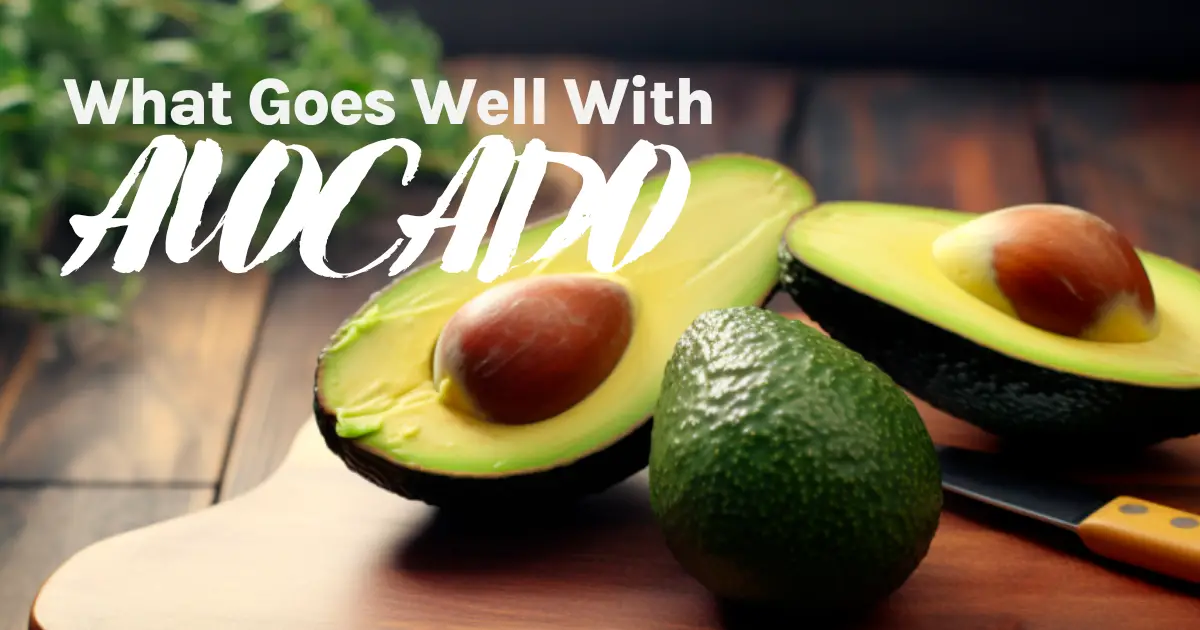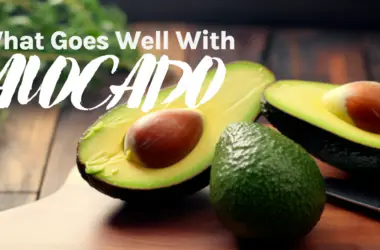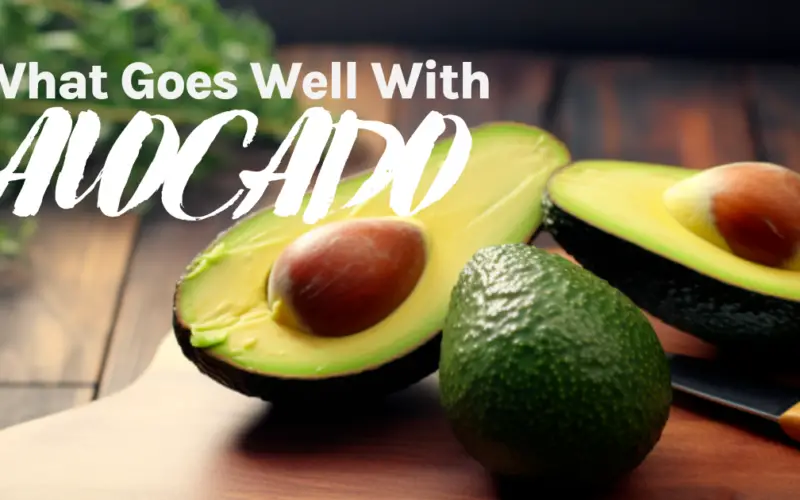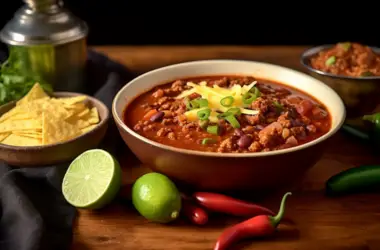Table of Contents Show

Avocado, with its rich, creamy texture and mild, buttery flavor, has become a beloved fruit (yes, it’s a fruit!) around the world.
Whether you’re a fan of avocado toast, guacamole, or simply enjoy its velvety goodness on its own, there’s no denying that this versatile fruit has captured the hearts and taste buds of many.
But have you ever wondered what goes well with avocado?
In this comprehensive blog post, we will dive into the world of avocado pairings, exploring a multitude of delicious and satisfying combinations.
Avocado is not just a tasty addition to your meals; it also brings a wealth of nutritional benefits to the table.
Packed with heart-healthy monounsaturated fats, fiber, vitamins, and minerals, avocados have earned their reputation as a nutrient-dense superfood.
They are known to support cardiovascular health, aid in weight management, and contribute to overall wellness.
Understanding what pairs well with avocado can elevate your culinary experiences and open up a whole new realm of flavors.
From breakfast to dessert, salads to main courses, and even snacks, there are endless possibilities for incorporating avocado into your meals.
Whether you’re a seasoned avocado aficionado or new to the avocado game, this blog post will provide you with an extensive guide to creating harmonious and delicious combinations.
Before we delve into the world of avocado pairings, let’s take a moment to appreciate the history and nutritional benefits of this remarkable fruit.
Avocado, scientifically known as Persea americana, is believed to have originated in south-central Mexico around 7,000 years ago.
The name “avocado” is derived from the Nahuatl word “ahuacatl,” which means “testicle” due to its shape.
The Aztecs considered avocados to be an aphrodisiac and believed in its ability to enhance fertility.
Today, avocados are grown in many different regions around the world, with Mexico, the Dominican Republic, and Colombia being the leading producers.
They come in various shapes, sizes, and colors, including the popular Hass avocado, known for its dark, bumpy skin and creamy flesh.
Avocados are harvested when they are mature but not fully ripe, and they continue to ripen off the tree.
This allows consumers to enjoy avocados at different stages of ripeness, depending on their preferences and culinary needs.
Avocados are not only delicious but also incredibly nutritious. They are an excellent source of healthy monounsaturated fats, which can help reduce bad cholesterol levels and lower the risk of heart disease.
Additionally, avocados are rich in fiber, which aids digestion and promotes feelings of fullness.
They also contain an array of essential vitamins and minerals, including vitamins K, C, E, B5, B6, folate, and potassium.
The versatility of avocado extends beyond its taste and nutritional profile. It can be used in various culinary applications, adding a creamy and luscious element to dishes.
From breakfast to dessert, avocado can be incorporated into an array of recipes, bringing its unique flavor and texture to the forefront.
Whether you’re seeking a savory, tangy, or sweet combination, avocado has the ability to complement and enhance a wide range of ingredients.
In the following sections, we will explore the perfect pairings for avocado in different food categories. We will dive into breakfast options, where avocado can elevate classics like toast, omelets, and smoothies.
We will then move on to salads and appetizers, discovering how avocado can transform a simple dish into a flavor-packed delight.
In the main dish section, we will explore the versatility of avocado in sandwiches, wraps, pasta, and even seafood and meat dishes.
Vegetarian and vegan recipes will also be covered, showcasing how avocado can be a star ingredient in plant-based creations.
Finally, we will explore the world of avocado in desserts and snacks, exploring indulgent yet nutritious options that will satisfy your sweet tooth.
So, whether you’re looking to explore new ways to enjoy avocado or simply seeking inspiration for your next culinary adventure, join us as we embark on this avocado-filled journey.
Get ready to discover the perfect companions for avocado and unlock a whole new world of flavors and possibilities. Let’s dive in and explore the incredible potential that avocado has to offer!
Avocado Pairings with Different Foods
Avocado’s creamy texture and mild, buttery flavor make it a perfect accompaniment to a wide range of foods.
Whether you’re starting your day with a hearty breakfast, enjoying a refreshing salad or appetizer, preparing a satisfying main dish, exploring vegetarian and vegan recipes, or indulging in desserts and snacks, avocado can take your culinary creations to the next level.
In this section, we will delve into each category, exploring the endless possibilities of avocado pairings.
Avocado and Breakfast
Breakfast is often considered the most important meal of the day, and avocado can be a delightful addition to kick-start your mornings.
One of the most popular ways to enjoy avocado for breakfast is in the form of avocado toast.
The creamy avocado spread on a slice of toasted bread creates a harmonious blend of flavors and textures.
You can customize your avocado toast with various toppings like eggs, smoked salmon, tomatoes, or feta cheese, adding a burst of freshness and extra nutrients.
If you’re in the mood for something warm and comforting, incorporating avocado into omelets and scrambled eggs can elevate your breakfast experience.
The creamy avocado adds a velvety richness to the eggs, while the combination of flavors provides a satisfying and nourishing start to your day.
Additionally, avocado can also be blended into smoothies and bowls, imparting a creamy consistency and enhancing the nutritional value of your morning beverage.
Avocado in Salads and Appetizers
When it comes to salads and appetizers, avocado is a versatile ingredient that can take your dishes to new heights.
Classic avocado salads, such as the ever-popular avocado and tomato salad or avocado and cucumber salad, offer a refreshing and vibrant combination of flavors.
The creamy avocado pairs well with the crispness of fresh vegetables, creating a delightful contrast in every bite.
Additionally, avocado can be cubed or sliced and used as a topping for other salads, adding a creamy element and enhancing the overall texture.
Avocado-based dips and spreads, such as guacamole or avocado hummus, are also crowd-pleasers when it comes to appetizers.
The smooth and creamy consistency of avocado lends itself perfectly to these dips, creating a luxurious and flavorful base.
Paired with crunchy tortilla chips, pita bread, or fresh vegetable sticks, avocado dips are a delicious and healthy option for parties or gatherings.
Avocado in Main Dishes
Avocado can play a significant role in enhancing the flavors and textures of main dishes, whether you’re preparing sandwiches, wraps, pasta, or even seafood and meat dishes.
In sandwiches and wraps, avocado adds a creamy element that complements the other ingredients, creating a satisfying and well-rounded meal.
The combination of avocado, lettuce, tomato, and protein (such as chicken or bacon) is a classic favorite that never disappoints.
When it comes to pasta dishes, avocado can be used to create creamy sauces or dressings that are lower in saturated fat compared to traditional cream-based sauces.
By blending avocado with herbs, garlic, lemon juice, and other seasonings, you can achieve a rich and velvety sauce that coats the pasta perfectly.
Adding avocado to seafood and meat dishes, such as grilled shrimp or steak salads, can provide a refreshing and nutritious twist, making your meals more interesting and enjoyable.
Avocado in Vegetarian and Vegan Recipes
For those following a vegetarian or vegan lifestyle, avocado can be a game-changer, providing a rich and satisfying element to plant-based dishes.
Whether you’re looking to add a creamy texture to burgers and sandwiches or seeking to incorporate avocado into tacos and burritos, there are numerous ways to explore the versatility of this fruit in vegetarian and vegan recipes.
Avocado in Plant-Based Burgers and Sandwiches
Plant-based burgers have gained immense popularity in recent years, and avocado can be a fantastic addition to elevate the flavor and texture of these meat-free creations.
By mashing or slicing avocado and layering it on top of a veggie patty, you can add a creamy and luscious element that enhances the overall taste.
The combination of plant-based proteins, fresh vegetables, and avocado creates a satisfying and nutritious burger experience.
Similarly, in sandwiches, avocado can take the place of traditional spreads like mayonnaise or cheese, providing a healthier alternative packed with beneficial fats.
The creamy consistency of avocado complements various sandwich fillings, from roasted vegetables to grilled tofu or tempeh.
Whether you’re making a classic veggie sandwich or experimenting with unique flavor combinations, avocado can take your plant-based sandwiches to a whole new level.
Avocado in Vegetarian Tacos and Burritos
Tacos and burritos are versatile dishes that lend themselves perfectly to vegetarian and vegan adaptations. Avocado can be a star ingredient in these Mexican-inspired delights, bringing a creamy and refreshing element to your creations.
In vegetarian tacos, avocado can be sliced or mashed and used as a topping, adding a burst of flavor and a delightful creamy texture.
Whether you’re preparing roasted vegetable tacos, black bean tacos, or tofu tacos, avocado can enhance the overall taste experience.
When it comes to burritos, avocado can be mashed and spread on the tortilla as a base, providing a creamy layer that binds the ingredients together.
Combine avocado with beans, rice, grilled vegetables, and your choice of plant-based protein for a satisfying and flavorful burrito.
The creamy avocado acts as a natural sauce, adding richness and depth to each bite.
Avocado in Vegan Desserts and Smoothies
Avocado might not be the first ingredient that comes to mind when thinking of desserts, but its creamy texture and mild flavor make it a fantastic addition to vegan sweet treats.
In baking, avocado can be used as a substitute for butter or eggs, creating moist and rich desserts.
Avocado can be pureed and incorporated into recipes for cakes, brownies, and even cookies, providing a healthier alternative without compromising on taste and texture.
Avocado also shines in the realm of frozen desserts.
By blending ripe avocado with plant-based milk, sweeteners, and other ingredients such as cocoa powder or fruits, you can create creamy vegan ice cream or popsicles.
These frozen treats are not only delicious but also packed with the nutritional benefits of avocado, making them a guilt-free indulgence.
Additionally, avocado can be a secret ingredient in vegan smoothies, adding a creamy consistency and boosting the nutritional content.
By combining avocado with fruits, leafy greens, and plant-based protein sources like hemp seeds or nut butter, you can create a filling and satisfying smoothie that is both delicious and packed with essential nutrients.
Avocado in Desserts and Snacks
Avocado’s creamy texture and mild flavor might be commonly associated with savory dishes, but it can also be a surprising and delightful addition to desserts and snacks.
Whether you’re looking to create sweet treats like cakes and brownies or seeking a healthy snack option, avocado can bring its unique characteristics to the table, providing both indulgence and nourishment.
Avocado in Sweet Treats like Cakes and Brownies
When it comes to baking, avocado can be used as a substitute for traditional ingredients like butter or eggs, offering a healthier alternative without compromising on taste or texture.
The creamy consistency of avocado adds moisture and richness to baked goods, resulting in deliciously moist cakes and brownies.
In cake recipes, avocado can be pureed and incorporated into the batter, providing a velvety texture and a subtle nutty flavor.
This makes it an excellent choice for chocolate cakes, where the avocado’s mild taste complements the richness of cocoa.
Avocado can also be utilized in frosting and fillings, adding a silky smoothness and a touch of green hue to your creations.
Similarly, in brownie recipes, mashed avocado can replace butter, resulting in fudgy and decadent treats.
The avocado’s natural fats contribute to the moistness of the brownies, making them irresistible to chocolate lovers.
The subtle flavor of avocado blends seamlessly with the chocolate, creating a harmonious balance of flavors.
Avocado in Frozen Desserts like Ice Cream and Popsicles
If you’re craving a frozen treat, avocado can be your secret ingredient for creating creamy and refreshing desserts.
By blending ripe avocado with plant-based milk, sweeteners, and other flavorings, you can whip up a batch of luscious avocado ice cream.
The natural creaminess of avocado eliminates the need for dairy, making it a perfect option for those with lactose intolerance or following a vegan lifestyle.
Avocado-based ice cream can be customized with various add-ins, such as cocoa powder, vanilla extract, or fruit purees, to create a wide array of flavors.
The result is a velvety smooth ice cream that is both satisfying and nutritious, thanks to the healthy fats and nutrients present in avocado.
For a lighter and more refreshing option, avocado can also be used to create homemade popsicles.
By blending avocado with fruits, such as berries, mango, or pineapple, and a sweetener of your choice, you can create a fruity and creamy popsicle that is perfect for hot summer days.
These avocado-based frozen treats are not only delicious but also provide a boost of vitamins, minerals, and healthy fats.
Avocado as a Healthy Snack Option
Avocado can also shine as a standalone snack, offering a nutritious and satisfying option for those looking for a quick and nourishing bite.
Simply cut an avocado in half, remove the pit, and sprinkle it with a pinch of salt and pepper. Scoop out the creamy flesh with a spoon and enjoy it as is.
The natural creaminess of avocado makes it a filling and satisfying snack that can keep you satiated between meals.
If you’re feeling more adventurous, you can get creative with avocado-based snacks. Mash avocado with lime juice, garlic, and spices to create a flavorful guacamole.
Pair it with crunchy tortilla chips or fresh vegetable sticks for a satisfying and nutritious snack option.
Alternatively, you can spread mashed avocado on whole-grain crackers or rice cakes, topping it with sliced tomatoes or a sprinkle of sea salt for a simple, yet delicious snack.
Avocado’s versatility extends to its snack potential, making it an excellent choice for those seeking a balance between taste and nutrition.
Whether you’re enjoying it on its own or incorporating it into dips and spreads, avocado can be a healthy snack option that satisfies your cravings while providing essential nutrients.
Tips for Selecting and Preparing Avocado
To fully enjoy the culinary potential of avocado, it is essential to know how to select, ripen, and prepare this versatile fruit.
In this section, we will provide you with a comprehensive guide that covers everything from choosing the perfect avocado to storing it properly and preventing browning.
By following these tips, you can ensure that you have the best avocados on hand and maximize their flavor and texture in your dishes.
How to Choose Ripe Avocados
When it comes to selecting avocados, it’s crucial to know how to choose ripe ones that are ready to eat.
The ripeness of an avocado can be determined by its color, texture, and firmness.
A ripe avocado typically has a dark green or almost black skin, although the color may vary depending on the variety.
Gently squeeze the avocado in the palm of your hand – it should yield slightly to gentle pressure without feeling overly soft or mushy.
Another useful indicator of ripeness is the area around the stem. Remove the small stem at the top of the avocado to reveal the color underneath.
If it is green, the avocado is likely ready to eat.
However, if it is brown, the avocado may be overripe or even spoiled. It’s always a good idea to inspect the avocado for any signs of bruising or blemishes, as these can indicate poor quality.
How to Ripen Avocados at Home
If you find yourself with unripe avocados, there are several methods you can use to speed up the ripening process at home.
One simple method is to place the avocados in a brown paper bag along with a ripe banana or apple.
These fruits release ethylene gas, a natural ripening agent that can accelerate the ripening of avocados.
Keep the bag at room temperature and check the avocados daily until they reach the desired ripeness.
If you need to ripen avocados quickly, you can try the microwave method.
Pierce the avocados with a fork or knife to create small holes, then microwave them on a low power setting for 30-second intervals.
Check the avocados after each interval until they reach the desired ripeness.
Be cautious not to overdo it, as microwaving for too long can cause the avocados to become mushy.
Proper Ways to Cut and Store Avocados
Once your avocados are ripe and ready to eat, it’s time to cut and store them properly to maintain their freshness.
To cut an avocado, use a sharp knife and slice it lengthwise around the pit. Twist the two halves in opposite directions to separate them.
To remove the pit, gently strike it with the blade of the knife and twist to release it.
Be careful when handling the knife to prevent any accidents.
To remove the flesh from the skin, use a spoon to scoop it out or make lengthwise cuts in the flesh and peel it like a banana.
If you only need a portion of the avocado, leave the pit in the remaining half and rub the exposed flesh with lemon or lime juice to prevent browning.
Then, tightly wrap the remaining half in plastic wrap or store it in an airtight container in the refrigerator.
The pit and citrus juice will help delay the browning process.
Preventing Avocado from Browning
Avocado flesh tends to oxidize and turn brown when exposed to air, but there are several methods you can use to prevent browning and keep your avocado dishes looking fresh and appetizing.
One effective method is to squeeze lemon or lime juice over the exposed flesh of the avocado.
The citric acid acts as an antioxidant and slows down the browning process.
Alternatively, you can use vinegar or olive oil to achieve a similar effect.
Another popular technique is to cover the exposed flesh tightly with plastic wrap, ensuring that no air can come into contact with the avocado.
The plastic wrap creates a barrier, preventing oxidation and browning.
Some people also recommend leaving the avocado pit in the dish, as it is believed to help slow down browning, although the effectiveness of this method varies.
If you only need a small portion of avocado, keep the pit intact and store it with the unused portion.
Again, rub the exposed flesh with lemon or lime juice and tightly wrap it in plastic wrap or place it in an airtight container.
The combination of the pit and the citrus juice will help preserve the avocado and delay browning.
By following these tips for selecting, ripening, and preparing avocados, you can ensure that you have the perfect fruit for your culinary adventures.
Whether you’re enjoying avocado in salads, main dishes, or desserts, these techniques will help you make the most of this versatile fruit.
So go ahead and confidently select and prepare your avocados, knowing that you’re well-equipped to enjoy their deliciousness to the fullest.
Health Benefits of Avocado
In addition to its delicious taste and culinary versatility, avocado offers a multitude of health benefits that make it a valuable addition to any diet.
Packed with essential nutrients and healthy fats, avocados have gained recognition as a nutrient-dense superfood.
In this section, we will delve into the nutritional profile of avocados and explore their potential impact on heart health, weight management, and overall well-being.
Nutritional Profile of Avocados
Avocados are a nutritional powerhouse, containing an impressive array of vitamins, minerals, and beneficial plant compounds.
One serving of avocado (approximately 100 grams) contains:
- Calories: 160
- Fat: 15 grams (healthy monounsaturated fats)
- Carbohydrates: 9 grams (7 grams of fiber)
- Protein: 2 grams
- Vitamin K: 26% of the Recommended Dietary Allowance (RDA)
- Vitamin C: 17% of the RDA
- Vitamin E: 10% of the RDA
- Vitamin B5: 14% of the RDA
- Vitamin B6: 13% of the RDA
- Folate: 20% of the RDA
- Potassium: 14% of the RDA
Avocados are also a rich source of antioxidants, including carotenoids such as lutein and zeaxanthin, which are beneficial for eye health. These antioxidants help protect the body against oxidative stress and reduce the risk of chronic diseases.
Role of Avocados in Heart Health
Avocados have gained recognition for their potential positive impact on heart health.
The monounsaturated fats found in avocados, particularly oleic acid, have been shown to help reduce levels of LDL (bad) cholesterol and increase levels of HDL (good) cholesterol.
This can contribute to a healthier lipid profile and a reduced risk of heart disease.
Additionally, avocados are a good source of potassium, a mineral that plays a crucial role in maintaining healthy blood pressure levels.
Adequate potassium intake is associated with a lower risk of high blood pressure, a major risk factor for heart disease.
The combination of healthy fats, fiber, and antioxidants in avocados also contributes to their heart-protective effects.
The fiber helps regulate cholesterol levels and promotes satiety, which can aid in weight management and prevent overeating.
Avocados as a Source of Healthy Fats
Avocados are often praised for their high content of healthy monounsaturated fats. These fats, predominantly oleic acid, are beneficial for overall health and well-being.
Monounsaturated fats have been linked to a reduced risk of heart disease, improved insulin sensitivity, and a lower risk of inflammation.
The inclusion of healthy fats in the diet is essential for the absorption of fat-soluble vitamins, such as vitamins A, D, E, and K.
Including avocados in meals that contain fat-soluble vitamins can enhance their absorption and maximize their nutritional benefits.
Moreover, the monounsaturated fats in avocados provide a stable source of energy and help maintain satiety.
Including avocados in meals can help you feel more satisfied and potentially prevent overeating, contributing to weight management.
Avocado’s Impact on Weight Management
Contrary to popular belief, avocados can be a valuable addition to a weight management plan.
Despite their relatively high calorie and fat content, the combination of healthy fats, fiber, and other nutrients in avocados can support weight loss and maintenance.
The fiber in avocados promotes feelings of fullness and helps regulate appetite, which can prevent overeating and unnecessary snacking.
Including avocado in meals can help you feel satisfied for longer periods, reducing the likelihood of reaching for unhealthy, calorie-dense foods.
Furthermore, the healthy fats found in avocados can contribute to a more balanced and sustainable approach to weight management.
These fats provide a steady source of energy, helping to stabilize blood sugar levels and prevent energy crashes that can lead to cravings for sugary or high-calorie foods.









